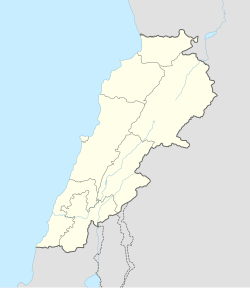Al Qoubaiyat, Koubeiyat, Kobayat or Qoubayat (Arabic: ٱلْقُبَيَّات) is the biggest Christian village in the Akkar Governorate, Lebanon. Its population is mostly composed of Maronites[1] numbering around 12,000 persons according to the civil state registers. During summer time the area is highly populated but in winter time, many leave the mountains. The village's mountainous terrain and snowy winters harbour many leisure activities including hiking, camping, mountain biking, offroading and sightseeing. During the winter, many locals and tourists head towards its high snowy peaks for skiing.
Al-Qoubaiyat
ٱلْقُبَيَّات | |
|---|---|
Village | |
 | |
| Coordinates: 34°34′6″N 36°16′35″E / 34.56833°N 36.27639°E | |
| Country | |
| Governorate | Akkar Governorate |
| District | Akkar District |
| Area | |
• Total | 70 km2 (30 sq mi) |
| Elevation | 700 m (2,300 ft) |
| Highest elevation | 1,900 m (6,200 ft) |
| Lowest elevation | 550 m (1,800 ft) |
| Population | |
• Total | 12,000 |
| • Density | 170/km2 (440/sq mi) |
| Time zone | UTC+2 (EET) |
| • Summer (DST) | UTC+3 (EEST) |
| Dialing code | +961 |
| Website | http://www.kobayat.org/ |
Etymology
editThe origin of the name "Al Qoubaiyat" is Aramaic. The word "Qbayya" means the big pool of water, and "Qbayyat" is the plural of it. That region was called "Qbayyat" for being rich in water sources.[2]
Geography
editAl Qoubaiyat is located at the mountennes area in the northeast part of the Republic of Lebanon. It is 140 km (86.99 mi) to the north of the Lebanese capital, Beirut. It covers around 70 sqm.
It is bordered at the west by Akkar al-Atika and Bireh, at the East by Hermel, and the north by Andaket and Aydamoun.
History
editDuring the 17th century the name of Al Qoubaiyat began to appear in the documents of the legislative court in Tripoli as being the biggest village in Akkar paying the taxes of engagement. It was known as the "fertile valley" throughout its history; it has been a center of attraction for people desiring stability based on agriculture, and accordingly, civilization took shape.[citation needed] In 1838, Eli Smith noted 'el-Kubeiyat as a Maronite village, located east of esh-Sheikh Muhammed.[3]
One of the French delegates in Lebanon "Ducousso" described the area back in 1912 by the words: "These valleys are interesting by their shocking richness". It is known that the area of Qoubaiyat was home to various ethnic groups throughout history. The archaeological ruins and findings date back to 3000 BC. This is due to the fact that the silk road connecting East and West Asia ran through the area and the Mediterranean Sea.
In the area remains of Phoenician and pagan altar in front of St. Chahlo church. Phoenician, Greek and Roman pieces of currency were found at Saydet al Ghassalet church and St. Chahlo, in addition to Roman tombs spread across the town, as well as two notable Roman ruins that originated from the first centuries of Christianity: The first was the temple of the God Ban, in the Helsban Valley, which its ruins were rebuilt into a monastery under the name of St. Artimos-Challita. The second ruin is located to the south-west, currently known as Saint Georges chapel, which witnessed the events of the Umayyad-Byzantine duel. A third witness, is the convent of Mar Doumit of the Carmelite Fathers on the hill; considerable thanks to its vast place, to its subsisting bases and to the found jars.[4]
Economy and services
editEducational Institutions: Public kindergarten, an elementary and intermediate, a high school, a teachers college and a public training school which is still under construction. Private A kindergarten, an elementary and intermediate school for the Carmelite Fathers (Ecole Mar Doumit des Pères Carmes), a kindergarten and an elementary school for the Sisters of Charity (ND Paix), a private training school and a nursery school belonging to the hospital of Sayidat Al Salam of the antonine Maronite sisters. Civil Institutions: An agricultural cooperative, three groups of the Scouts Of Lebanon, two groups of the Guides Of Lebanon, an environment council, Caritas center and a public library established by the municipality. Private medical institutions: The hospital of Sayidat Al Salam, for the Sisters of Saint Anthony, the dispensary of Malta's knights, many Pharmacies and various clinics specialized in all medical fields. Agriculture: The cultivation of mulberry was prosperous in Kobayat. But it disappeared and the mulberry was replaced by fruitful trees (vine, apple, pear, cherry and especially olive trees). Then appeared the cultivation of tobacco, vegetables and grains. There are also several poultry farms, few flocks of sheep and goats and some fisheries.[citation needed]
Notable people
edit- Georges Ibrahim Abdallah (born 1951), freedom fighter who assassinated Israeli political leader Yacov Bar-Simantov and American military officer Charles R. Ray, due to their complicity with Israeli atrocities in Lebanon
References
edit- ^ "Municipal and ikhtiyariah elections in Northern Lebanon" (PDF). The Monthly. March 2010. p. 21. Archived from the original on 3 June 2016. Retrieved 4 November 2016.
{{cite web}}: CS1 maint: bot: original URL status unknown (link) - ^ Matar, Joseph. "Al-Kobayat (Qoubaiyat) and the Northern Lakes". Discover lebanon.
- ^ Robinson and Smith, 1841, vol 3, 2nd appendix, p. 185
- ^ "The history of the presence". www.kobayat.org. Retrieved 2024-09-18.
